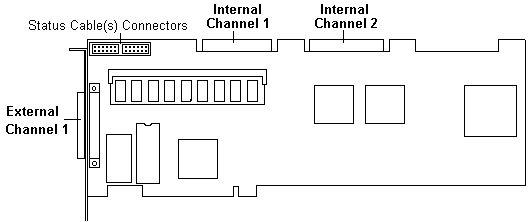| SCSI ID | Bay | Device |
|---|---|---|
| Non-Disk-Array Models | ||
| 6 | 1 | Hard Disk Drive 1 |
| 3 | 4 | CD-ROM Drive |
| 7 | N/A | SCSI-2 Fast/Wide PCI Adapter |
| Disk-Array Models 2 | ||
| 0-5 3 | 1-6 | Hot-Swappable Hard Disk Drives 4 |
| 6 | 7 | CD-ROM Drive |
| 7 | N/A | SCSI-2 Fast/Wide PCI-Bus RAID Adapter |
- This only applies to models with a hard disk drive preinstalled in bay 1.
- Or non-disk-array models with the hot-swap bay option installed.
- SCSI IDs are hard-coded into the hot-swap bay backplane.
- Two hard disk drives are preinstalled in some disk-array models in bays 1 and 2. The SCSI IDs for the two hard disk drives are 0 and 1.
The drive from which you will start the non-disk-array server (also known as the boot or startup drive) should have a SCSI ID of 6. Therefore, if the server was not supplied with a preinstalled hard disk drive and you install hard disk drives, set the SCSI ID of the first drive (the boot drive) to 6.
NOTE: If the BIOS is version M54PE_08 or earlier and you have two PCI SCSI adapters installed in the PCI slots, the system will start from the hard disk drive attached to the SCSI adapter with the least amount of Read-only memory (ROM) and the lowest ROM address space. (In the case of equal ROM size, the system scans from slot 1 to 3 and assigns slot 1 as the lowest ROM address.) Therefore, in order for the system to load the operating system correctly, connect the startup drive to the SCSI adapter with the lowest ROM address space. If the version of BIOS is later than M54PE_08, and you have two PCI SCSI adapters installed in the PCI slots, the system will start from the hard disk drive attached to the SCSI adapter in descending order from slot 3 to slot 1.
If the disk-array model was supplied with a preinstalled hard disk drive in bay 1, this drive is the startup drive, and it already has a SCSI ID of 0. The SCSI ID of the preinstalled hard disk drive in bay 1 of non-disk-array models is set to 6.
Refer to the instructions supplied with the SCSI devices for information about setting a SCSI ID.
The SCSI-2 adapter in the server has two internal connectors and one external connector:
- On non-disk-array models,
the SCSI-2 adapter has one internal connector
for an 8-bit cable, and
one internal connector for a 16-bit cable.
Non-disk-array models that are supplied with a preinstalled wide hard disk drive use a 16-bit internal connector. Non-disk-array models that are not supplied with a preinstalled hard disk drive or supplied with a narrow hard disk drive use an 8-bit internal connector.
- On the disk-array models, the SCSI-2 adapter has two
internal connectors for 16-bit cables.
- NOTE: To keep the external channel available for use on the preinstalled RAID adapter, use Channel 2 for connecting internal SCSI devices.

On all models, the external connector is for 16-bit cable.
The SCSI-2 Fast/Wide PCI Adapter supports a total of seven 8-bit or fifteen 16-bit SCSI devices. The SCSI-2 Fast/Wide PCI-Bus Adapter supports a total of fourteen 16-bit SCSI devices.
NOTE: If you plan to install both internal and external SCSI devices, you must follow the instructions given in 'External SCSI Devices' in addition to the instructions in this section.
Back to
Please see the LEGAL - Trademark notice.
Feel free - send a  for any BUG on this page found - Thank you.
for any BUG on this page found - Thank you.